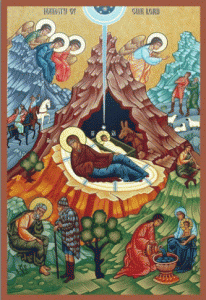 Icons are a theology, a theology in color, expressing the experience of God with lines and paints rather than with discursive language. The goal of icons and that of written theology are the same – to lead others to the mystical experience of God. The icon of the Nativity of our Lord is packed with theology. Most comes from Holy Scripture and all comes from Tradition. It depicts in paint the Incarnation, God being man, and the beginning of our salvation.
Icons are a theology, a theology in color, expressing the experience of God with lines and paints rather than with discursive language. The goal of icons and that of written theology are the same – to lead others to the mystical experience of God. The icon of the Nativity of our Lord is packed with theology. Most comes from Holy Scripture and all comes from Tradition. It depicts in paint the Incarnation, God being man, and the beginning of our salvation.
In the traditional icon of the Nativity, a number of different persons are depicted. There are, of course, angels. Some stand in awe at the great mystery. Some announce the news to the simple shepherds. The foreign Magi, also known as the Three Kings, are there to announce that salvation is for all humankind. Also depicted are midwives bathing the Christ Child in order to reinforce the belief that He is human.
In the lower part of the icon, both Joseph is being tempted by an evil spirit depicted as a shepherd, not to believe Mary’s story that the child is special and that this is a virgin birth. It should be noted that Joseph, by Eastern Christian tradition, is shown as an older, widowed man. Joseph, because he trusted Mary, overcomes this temptation and becomes the protector of the Virgin Mary and the guardian of Jesus.
The Virgin Mary is shown looking towards Joseph, relying on her Lord, praying that he will not listen to Satan. Mary is lying on a red blanket signifying the color of life.
Next to the Child in the cave are an ox and donkey there to remind us of Isaiah 1:3, “The ox knows his owner and the donkey knows his master’s crib. But Israel does not know, and my people do not consider me.”
Christ is shown in a dark cave to represent that He is the light of the world. Christ is wrapped in swaddling clothes and in a crib. The crib symbolizes the future tomb in which He will be laid and the swaddling clothes the shroud that will cover Him in His burial. This is done intentionally to illustrate that the purpose of the Incarnation of Christ was to make possible the Crucifixion and Resurrection.
The entire story of Christ, as it is presented by the Church, starts at the end, His death and Resurrection, and looks back to His birth.
